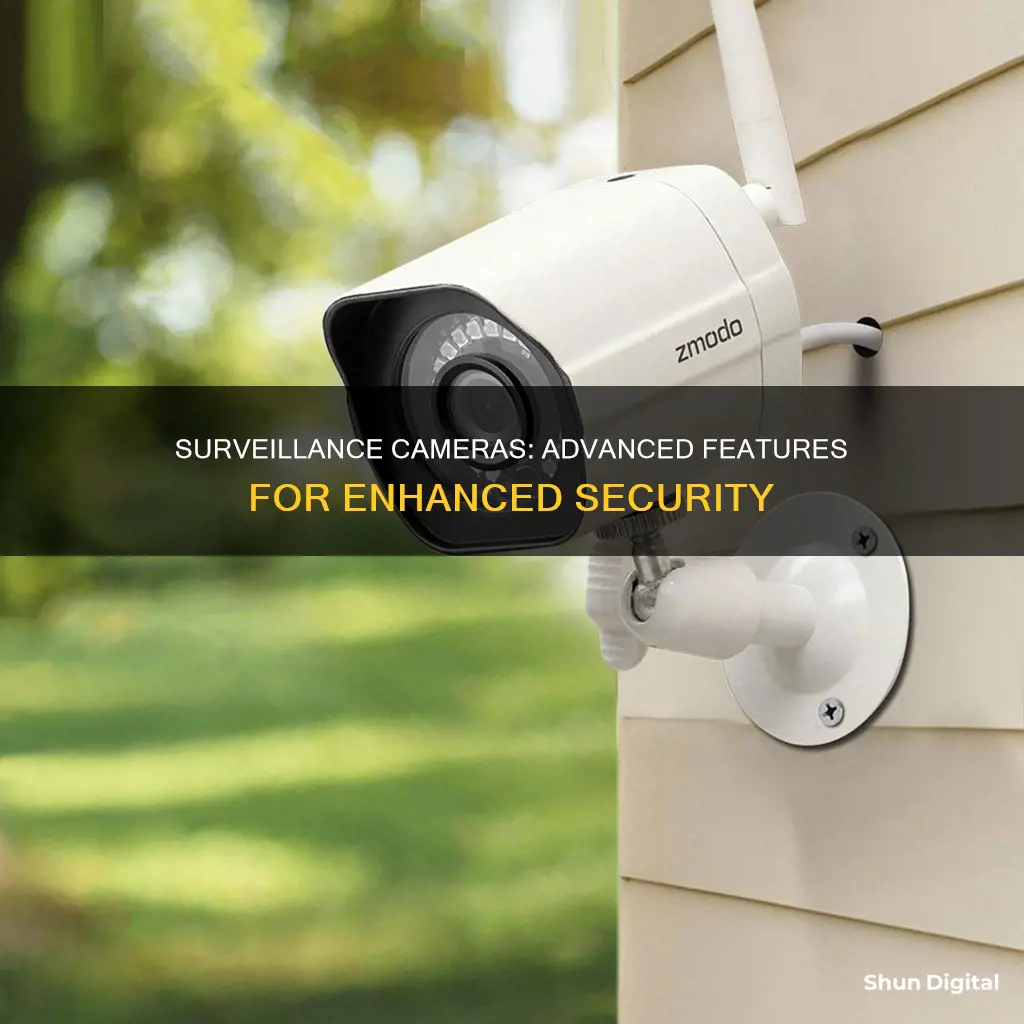
Surveillance cameras are an effective tool for security and monitoring, offering a range of features that enhance their performance and usability. From high-resolution imaging and wide-angle lenses to night vision capabilities and motion detection, these cameras provide clear and detailed footage, ensuring optimal surveillance. The latest advancements include features such as facial recognition, license plate recognition, and pan-tilt-zoom functionality, making these cameras even more versatile and effective. With the option of cloud storage and remote access, surveillance systems are now more secure and accessible than ever before.
| Characteristics | Values |
|---|---|
| Video Quality | High-resolution, 720p, 1080p, 2K, 4K, 8K |
| Lens | Wide-angle |
| Night Vision | Infrared LEDs, Thermal Imaging |
| Motion Detection | With advanced algorithms to differentiate human movement |
| Remote Access | Accessible through mobile devices or computers |
| Storage | Cloud, SD card, local hard drive |
| Advanced Features | Facial recognition, license plate recognition, pan-tilt-zoom (PTZ) |
| Audio | Two-way communication |
| Field of View | Narrower for more detail, wider for broader coverage |
| Durability | Weather-resistant, IP rating of 65 |
What You'll Learn

High-resolution imaging for clear and detailed footage
High-resolution imaging is an essential feature of surveillance cameras, providing clear and detailed footage that is invaluable for security and surveillance purposes. This feature ensures that the captured video is of high quality, making it easier to identify individuals and objects within the footage. The importance of high-resolution imaging is particularly evident when the footage is needed as evidence in criminal investigations or insurance claims.
With technological advancements, surveillance cameras now offer impressive resolutions, such as 4K and even 8K. These higher resolutions deliver exceptionally sharp and detailed images, facilitating improved identification and analysis of events. The enhanced clarity also aids in capturing crucial details such as license plate numbers or facial features, which are vital for solving crimes and identifying suspects.
In addition to high-resolution imaging, modern surveillance cameras incorporate other advanced features. For instance, many cameras are now equipped with night vision capabilities, enabling them to capture clear footage even in low-light conditions. This feature is especially useful for outdoor surveillance or in areas with inadequate lighting.
Another notable feature is the wide dynamic range (WDR) capability, which ensures that scenes with both bright and dark areas are properly exposed. This feature prevents the loss of details in overly bright or dark areas, providing a more accurate representation of the scene.
Furthermore, remote viewing capabilities in surveillance cameras have added convenience and flexibility for users. This feature allows users to access live or recorded footage from any location using their smartphones or computers. As a result, users can monitor their property or business remotely, enhancing security and peace of mind.
In summary, high-resolution imaging is a standout feature of surveillance cameras, delivering clear and detailed footage. With continuous technological advancements, surveillance cameras now offer even higher resolutions and a range of complementary features, such as night vision, wide dynamic range, and remote viewing capabilities. These advancements not only improve the effectiveness of surveillance cameras but also make them indispensable tools for security and surveillance applications.
Polaroid OneStep Close-Up: Battery Life Explained
You may want to see also

Wide-angle lenses for broader coverage
Wide-angle lenses are a great feature for surveillance cameras as they offer broader coverage, allowing for a wider field of view. This means that a single camera can monitor a larger area, reducing the need for multiple cameras and lowering costs. With a wide-angle lens, surveillance cameras can capture more details and provide a comprehensive view of the surroundings.
The field of view of a security camera largely depends on the lens focal length and the image sensor size. The longer the focal length, the narrower the field of view. Meanwhile, a larger image sensor will provide a wider field of view. For example, a 2.8mm lens will offer a 110-degree viewing angle, which is the widest viewing angle available. On the other hand, a 12mm lens will offer a narrower 29-degree angle but will allow you to see further in the distance.
Surveillance cameras with wide-angle lenses are ideal for monitoring large areas such as entryways, garages, lobbies, warehouses, conference rooms, and outdoor areas like parking lots. With a wide-angle lens, you can capture a wider range of activities, making it easier to detect suspicious behaviour or identify potential threats. This enhanced situational awareness is particularly useful in high-security areas such as airports, shopping malls, or government buildings, where a comprehensive view is crucial for effective surveillance.
In addition, advancements in wide-angle lens technology have improved the quality of surveillance footage. High-resolution wide-angle lenses can capture clear and detailed images, even in low-light conditions. This ensures that surveillance cameras can provide accurate and reliable evidence, making it easier for law enforcement agencies to investigate incidents and identify perpetrators.
Furthermore, wide-angle lenses can be combined with other features to enhance the effectiveness of surveillance systems. For example, pan-tilt-zoom (PTZ) capabilities allow the camera to move and zoom in on specific areas of interest within the wide-angle view, providing a closer look when needed. Intelligent video analytics can also be used to analyse the wide-angle footage in real time, detecting specific objects or behaviours and triggering alerts or automated actions.
Overall, wide-angle lenses offer a range of benefits for surveillance cameras, including broader coverage, enhanced situational awareness, improved image quality, and compatibility with advanced features. By utilising wide-angle lenses, surveillance systems can achieve effective monitoring and security in various environments.
The Ultimate Guide to TAC Camera Battery Options
You may want to see also

Night vision capabilities for low-light conditions
Night vision capabilities are essential for surveillance cameras to capture clear footage in low-light conditions. Ultra-low light security cameras, also known as "starlight cameras," are designed to excel in this regard, providing high-quality video surveillance even in near-total darkness. Here's how they achieve superior night vision:
Highly Sensitive Image Sensors
Starlight cameras are equipped with highly sensitive image sensors, such as back-illuminated CMOS sensors, that can capture usable images with minimal ambient light. These sensors maximize the amount of light that reaches the sensor, resulting in clearer and more detailed images in low-light conditions.
Large Aperture Lenses
These cameras often feature lenses with wide apertures, or low f-numbers, which allow more light to enter the lens. This simple yet effective technique improves the camera's overall low-light performance and results in brighter images.
Digital Noise Reduction (DNR)
DNR technology plays a crucial role in enhancing image clarity in low-light scenarios. It minimizes noise, such as graininess, in the images, ensuring that the footage remains sharp and detailed even when there is minimal light available.
Wide Dynamic Range (WDR)
WDR technology comes into play when dealing with scenes that have strong contrasts between light and dark areas. It ensures that details in both well-lit and shadowy regions are effectively captured, maintaining image clarity and visibility.
Intelligent Infrared (IR) Illumination
Some starlight camera models employ intelligent IR illumination to optimize lighting conditions for night vision. This feature ensures that the image is neither overexposed nor underexposed, providing a balanced and well-lit view even in complete darkness.
Frame Integration Techniques
Frame integration is a technique where light is accumulated over multiple frames, significantly improving image quality in extremely low-light conditions. This method allows the camera to gather more light information and create a clearer, more defined image.
"True" Color Night Vision
While some cameras rely solely on infrared illumination for night vision, starlight cameras with "true" color night vision use ambient light and advanced sensors to capture color-rich footage. This feature is particularly useful for identifying specific details, such as the color of a perpetrator's clothing or their vehicle.
In summary, ultra-low light security cameras, or starlight cameras, offer exceptional night vision capabilities by leveraging advanced technologies and features. These cameras are designed to capture clear, detailed, and color-accurate images in extremely low-light conditions, making them ideal for 24/7 security and monitoring, especially in outdoor and low-light indoor environments.
The Evolution of Camera Lens Covers
You may want to see also

Motion detection to trigger recording
Motion detection is an important feature of surveillance cameras, allowing for efficient use of hard drive space and enhancing security. This technology works by continuously monitoring each frame of video and averaging the background state of the scene. If a significant change is detected from one frame to the next, a motion event is triggered, and the camera begins recording. This can be achieved through optical-based motion sensors, which measure pixel changes, or PIR motion sensors, which detect body heat and infrared energy.
One of the key benefits of motion detection is the ability to preserve hard drive space. With motion-activated recording, you don't end up with hours of footage where nothing has happened, thus saving storage space and reducing the time needed to review footage. This also makes it easier to find and review relevant footage when needed.
Another advantage of motion detection is enhanced security. By triggering recording only when motion is detected, you can ensure that any activity in the monitored area is captured. This can help to deter intruders and prevent vandalism, theft, or other criminal activities. Additionally, with features like line crossing detection and region intrusion detection, you can set up specific areas of interest and receive alerts when those areas are breached.
Motion detection also helps to reduce false alarms. Traditional security systems with contact sensors on windows or doors are easily triggered by pets, loose sensors, or environmental factors. Motion detection can filter out these false triggers and notify you of actual motion events.
When setting up motion detection, it's important to consider the placement of your cameras. Place them near entry points and adjust the range and angle of detection to capture the areas of interest. You can also create motion detection zones to focus on specific areas, ensuring the camera only captures relevant footage. Experimenting with different sensitivity levels can help you find the right balance between detecting actual motion and reducing false triggers.
Overall, motion detection is a valuable feature for surveillance cameras, providing efficient storage, enhanced security, and improved accuracy in detecting and responding to potential threats.
Surveillance Cameras in Kentucky Bathrooms: What's the Law?
You may want to see also

Remote access and viewing
To set up remote access and viewing, you will need a capable web-based software platform that can be used offsite and is accessible on both desktop and mobile devices. This can be the same software platform as your onsite system, but you will need to configure user permissions and security settings to allow for remote access.
- Download a remote viewing app: Many security camera manufacturers offer their own apps that allow you to remotely view your camera feed. Download the relevant app to your smartphone or mobile device.
- Launch the app and set a password: Open the app and enter any required login information, such as a username and password, to access your account.
- Access the live view: Once you're logged in, you should be able to access the live view from your security camera. You may need to add the camera to the app by entering a unique ID number or scanning a QR code.
- Configure software settings: If needed, adjust any software settings to customize your remote viewing experience, such as notification preferences or motion detection settings.
It's important to note that remote access and viewing of security cameras come with potential security risks. To mitigate these risks, it's recommended to implement security strategies such as multi-factor authentication, strong passwords, and user permissions. Additionally, make sure your camera software and firmware are up to date to ensure the best protection against unauthorized access.
Strategies for Requesting Community Service for a Camera Ticket
You may want to see also
Frequently asked questions
Some great features for surveillance cameras include:
- High-resolution imaging for clear and detailed footage.
- Wide-angle lenses for broader coverage.
- Night vision capabilities for monitoring in low-light conditions.
- Motion detection to trigger recording when movement is detected.
- Remote access and viewing through mobile devices or computers.
- Cloud storage options for easy and secure data storage.
Additionally, advanced features such as facial recognition, license plate recognition, and pan-tilt-zoom (PTZ) functionality can further enhance the effectiveness and versatility of surveillance cameras.
High-resolution imaging ensures that the captured footage is of high quality, making it easier to identify individuals and objects. This is especially important when the footage may be used as evidence in criminal investigations or insurance claims. With advancements in technology, surveillance cameras now offer even higher resolutions, such as 4K and 8K, providing incredibly sharp and detailed images.
Wide-angle lenses provide a broader field of view, allowing a single camera to monitor a larger area. This reduces the need for multiple cameras, lowering costs. They also offer enhanced situational awareness, making it easier to detect suspicious behaviour or potential threats in high-security areas.







